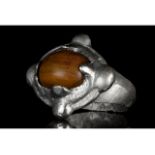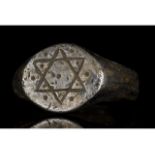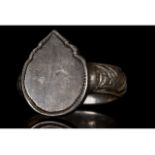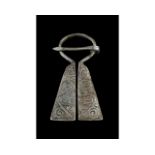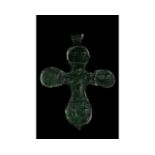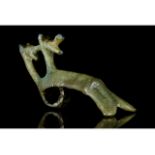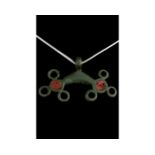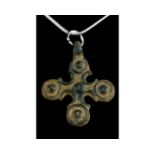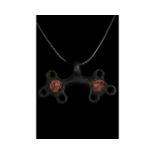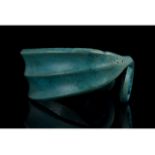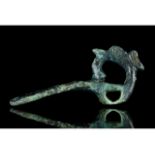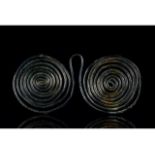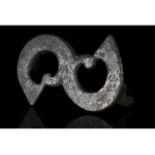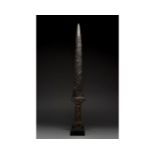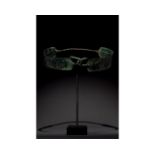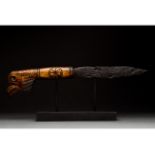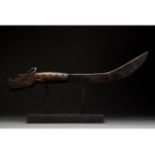Refine your search
Estimate
Category
- Arms, Armour & Militaria (102)
- Jewellery (80)
- Greek, Roman, Egyptian & Other Antiquities (54)
- Sculpture (35)
- Chinese Works of Art (25)
- Collectables (19)
- Glassware (15)
- Books & Periodicals (14)
- Scientific Instruments (14)
- Ceramics (11)
- Models, Toys, Dolls & Games (7)
- Taxidermy & Natural History (6)
- Coins (4)
- Vintage Fashion (4)
- Stamps (3)
- Metalware (2)
- Textiles (2)
- Bank notes (1)
- Furniture (1)
- Kitchenalia (1)
- Oil, Acrylic paintings & Mixed Media (1)
- Russian Works of Art (1)
- Salvage & Architectural Antiques (1)
- Silver & Silver-plated items (1)
Filtered by:
- Item Type
- List
- Grid
A subscription to the Price Guide is required to view results for auctions ten days or older. Click here for more information
Ca. 1300-1500 AD. Byzantine. A wearable gilded silver ring with a circular band with flared shoulders decorated with small linear incisions that f...
Ca. 900-1100 AD. Northern European. A beautiful silver ring comprising a lentoid-section hoop, flared shoulders, a discoid bezel with claw setting...
Ca. 1300-1500 AD. A wearable silver ring with a circular band, slightly flared shoulders, and an oval bezel decorated with an incised star of Davi...
MEDIEVAL SILVER RING
Ca. 1300-1500. Medieval Europe. A beautiful silver ring with a heavy circular band with a circular raised protrusion at the base and incised decor...
Ca. 300-100 BC. Hellenistic. A finely rendered matching pair of gold earrings, each formed from a circular wire hoop, which tapers towards one end...
Ca. 600-800 AD. Byzantine. A matched pair of gold earrings, each one comprising a hollow hoop with attached pearl, a hook-and-loop closure, and a ...
Ca. 1100-1400 AD. Medieval Western Europe. A Viking-inspired silver omega penannular brooch featuring flanges with two panels decorated with geome...
Ca. 1000-1300 AD. Medieval Western Europe. A beautiful bronze cross featuring rounded arms and mould-beaten decoration. The cross bears extensive ...
Ca. 900-1100 AD. Viking Age. A large bronze amulet with a cylindrical head flaring toward the bottom; five loops attached, each with figure-of-eig...
Ca. 500-300 BC. Scythian culture. A bronze fitting comprising an axe head-shaped body and two integral loops with zoomorphic decoration (perhaps a...
Ca. 900-1100 AD. Viking Age. A beautiful openwork pendant decorated with circular and rectangular openings of various sizes. The cross at the cent...
Ca. 300-500. European. A wearable Kiev culture bronze horse harness pendant with two discs at each terminal with red enamel filling to the centre ...
MEDIEVAL BRONZE CROSS PENDANT
Ca. 1000-1300 AD. Medieval Western Europe. A bronze cross with four equal-length arms with ribbed decoration. The centre of the cross and each of ...
Ca. 700-900 AD. Northern Europe. A beautiful silver pendant, with an integral loop, shaped like an axe head. Good condition. This type of amulet i...
Ca. 300-500. European. A wearable Kiev culture bronze horse harness pendant with two discs at each terminal with red enamel filling to the centre ...
ROMAN GLASS AND STONE NECKLACE
Ca. 100-300 AD. Roman. A beautiful restrung and fully wearable necklace made of a single string of white, orange, green and blue circular stone an...
ROMAN GLASS AND GOLD NECKLACE
Ca. 100-300 AD. Roman. A restrung and fully wearable necklace made of a single string of white, red, green and blue circular and flat glass beads ...
ROMAN GLASS AND STONE NECKLACE
Ca. 100-300 AD. Roman. A restrung and fully wearable necklace made of a single string of white, transparent, and blue glass and stone beads of var...
BRONZE AGE COILED BRACELET
Ca. 800-600 BC. Bronze Age. Europe. A heavy bronze bracelet with a flaring, ribbed midsection and coiled, spiral terminals. In the Bronze Age, bra...
LARGE ROMAN GLASS BRACELET
Ca. 100-300 AD. Roman. A wearable glass bracelet with green and orange inserts on an originally black background, the colour is still visible in s...
MEDIEVAL BRONZE TWISTED BRACELET
Ca. 900-1100 AD. Early Medieval. A beautiful Viking-ispired twisted 'fealty' bracelet or arm ring. Good condition; beautiful patina. Such type of ...
Ca. 900-1100 AD. Viking Age. A solid medieval bronze bracelet decorated with geometric patterns; the terminals of the bracelet are shaped as two s...
Ca. 900-1100 AD. Viking Age. A beautiful semi-circular bronze bracelet; the decoration is divided into rectangular sections with the same geometri...
MEDIEVAL BRONZE TWISTED BRACELET
Ca. 900-1100 AD. Early Medieval. A beautiful Viking-inspired twisted 'fealty' bracelet or arm ring. Good condition; beautiful patina. Such type of...
Ca. 100-300 AD. Roman. A well-preserved, wearable gold ring with a circular band, flared shoulder, and an oval bezel with inset black gemstone wit...
Ca. 900-1100 AD. Viking Age. A beautifully decorated silver ring comprising a circular hoop, flared shoulders with linear decoration, and a lozeng...
MEDIEVAL SILVER RING WITH CROSS
Ca. 1200-1300 AD. European. A beautifully decorated silver ring comprising a thin circular hoop and an applied circular bezel decorated with a sty...
Ca. 1200-1300 AD. European. A beautiful silver ring comprising a circular hoop, slightly tapering shoulders with three parallel linear incisions, ...
Ca. 1200-1300 AD. Crusaders period. A medieval silver ring with a thin circular band and an applied oval bezel decorated with a stylised star of B...
Ca. 900-1100 AD. Viking Age. A beautiful silver ring comprising a circular hoop, flared shoulders with raised central ridge, and a lozenge-shaped ...
Ca. 500-300 BC. Scythian culture. A bronze mount in the form of an abstract animal; good condition. Zoomorphic mounts were affixed to garments of ...
Ca. 900-1100 AD. Viking Age. A large bronze amulet with a cylindrical body and three loops to the lower edge, each with a figure-of-eight coiled l...
BRONZE AGE SPECTACLE PENDANT
Ca. 800-600 BC. Bronze Age. Europe. A beautiful Celtic bronze pendant formed as an omega-shaped plaque of round-section wire with coiled ends. Goo...
Ca. 100-200 AD. Roman. A rare swirling S-shaped brooch; the terminals of the S are joined together through small comma-shaped bronze extensions. G...
Ca. 100-300 AD. Roman. A very well-preserved bronze fibula, featuring an original catch-plate and pin. The body of the fibula consists of an onion...
Ca. 100 AD. Roman. An enamelled bronze brooch in the shape of a rabbit decorated with a central star flanked by two incised rabbits; good conditio...
ROMAN IRON SPATHA SWORD
Ca. 100-500 AD. Roman. An iron spatha with a long tapering, bevelled blade, and a reconstructed bone hilt with two circular termini, a final spike...
Ca. 1200-700 BC. Western Asiatic/Aegean. A stunning bronze sword with an elongated leaf-shaped blade, raised midrib, rounded guard and tubular gri...
ANCIENT AKINAKES IRON SWORD
Ca. 600-400 BC. Eastern Mediterranean. A very well preserved short iron sword of the akinakes type (Greek 'ἀκῑνάκης') with a pointed bevelled blad...
ANCIENT BRONZE LONG SPEAR HEAD
Ca. 1200-700 BC. Western Asiatic/Aegean. A long bronze spear with an elongated leaf-shaped blade with barbs, raised midrib, sharpened edges that t...
Ca. 1200-700 BC. Western Asiatic/Aegean. A long bronze spear with an elongated leaf-shaped blade with raised midrib, sharpened edges that taper gr...
Ca. 1200-700 BC. Western Asiatic/Aegean. A long bronze spear with an elongated leaf-shaped blade with raised midrib, sharpened edges that taper gr...
INTACT BRONZE AGE BELT
Ca. 1000-650 AD. Western Asiatic. A very rare, intact bronze belt made of two wide lateral bronze rectangular bands embellished with linear decora...
LARGE MEDIEVAL IRON SPEAR HEAD
Ca. 900-1100 AD. Viking age. An iron spearhead with a leaf-shaped blade, raised midrib, sharp edges flaring slightly before tapering to a pointed ...
ROMAN IRON SPEARHEAD
Ca. 300-500 AD. Roman. An iron spearhead with an elongated leaf-shaped blade, raised midrib, sharp tapering edges, and a long flared socket. Good ...
Ca. 100-300 AD. Roman. An iron pilum spearhead with a barbed, triangular blade, and a long, narrow neck, and a robust flaring socket. Good conditi...
Ca. 900-1400 AD. European. A beautiful knife with a well-preserved medieval iron blade with a curved tip. The antler bone handle has been reconstr...
Ca. 900-1400 AD. European. A beautiful knife with a well-preserved medieval iron blade curved upwards and antler bone handle reconstructed in Viki...
LONG ANCIENT BRONZE SPEAR HEAD
Ca. 1200-700 BC. Western Asiatic/Aegean. A long bronze spear with an elongated leaf-shaped blade with barbs, raised midrib, sharpened edges that t...
ANCIENT BRONZE SWORD
Ca. 1200-700 BC. Western Asiatic/Aegean. A bronze sword with an elongated leaf-shaped blade, raised midrib, and short tang for insertion into a hi...
Ca. 1200-700 BC. Western Asiatic/Aegean. A long bronze spear with an elongated leaf-shaped blade with raised midrib, sharpened edges that taper gr...
LONG ANCIENT BRONZE SPEAR HEAD
Ca. 1200-700 BC. Western Asiatic/Aegean. A long bronze spear with an elongated leaf-shaped blade with barbs, raised midrib, sharpened edges that t...
LONG ANCIENT BRONZE SPEAR HEAD
Ca. 1200-700 BC. Western Asiatic/Aegean. A long bronze spear with an elongated leaf-shaped blade with barbs, raised midrib, sharpened edges that t...
Ca. 1300 AD. Medieval Western Europe. An iron axe head with a curved blade, triangular cheek with a square lower edge, and square-shaped shaft hol...
VIKING IRON BATTLE AXE HEAD
Ca. 1000-1200 AD. Viking Age. An iron axe head comprising a short, curved blade, elongated cheek, lozenge-shaped poll and rounded socket. The bear...
VIKING IRON BATTLE AXE HEAD
Ca. 1000-1200 AD. Viking Age. An iron bearded axe head with an elongated, curved blade and tapering cheek. T The bearded axe, or Skeggøx (from Old...
ANCIENT BRONZE SPEAR ON STAND
Ca. 1200-700 BC. Western Asiatic/Aegean. A bronze leaf-shaped spearhead with a raised midrib and a short tang. Good condition, beautiful patina; c...
ANCIENT BRONZE SPEAR ON STAND
Ca. 1200-700 BC. Western Asiatic/Aegean. A bronze spear with a leaf-shaped blade with barbs, raised midrib, bevelled edges that taper to a pointed...
ANCIENT BRONZE SPEAR ON STAND
Ca. 1200-700 BC. Western Asiatic/Aegean. A bronze spear with a leaf-shaped blade with barbs, raised midrib, bevelled edges that taper to a pointed...
ANCIENT BRONZE SPEAR ON STAND
Ca. 1200-700 BC. Western Asiatic/Aegean. A bronze spearhead with a leaf-shaped, lentoid sectioned blade, raised midrib, a short socket and tang. G...



